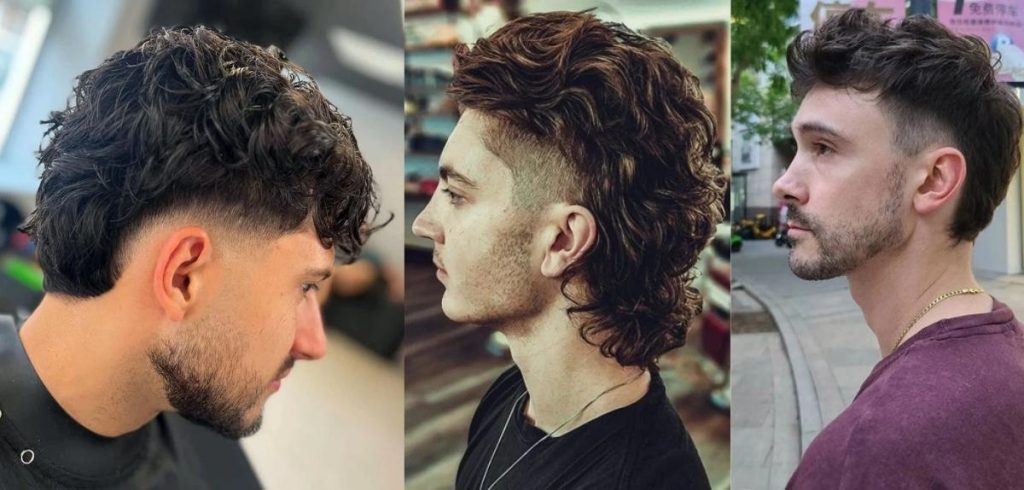The past few years have seen a full-circle moment in men’s hair trends — styles once considered retro are now ruling barbershops again. Among them, the burst fade and the mullet are stealing the spotlight, sparking one big question: Is a burst fade just a modern version of the mullet?
The short answer: No — but they’re often combined.
The burst fade is a technique, while the mullet is a shape. One’s about how hair is blended; the other’s about where it’s long or short. Still, the rise of the burst fade mullet — a sharp hybrid style that fuses the two — is what keeps this confusion alive. In this guide, we’ll break down what defines each cut, how they differ, and why the hybrid trend has everyone talking.
Defining the Classic Mullet (A Haircut of Structure)
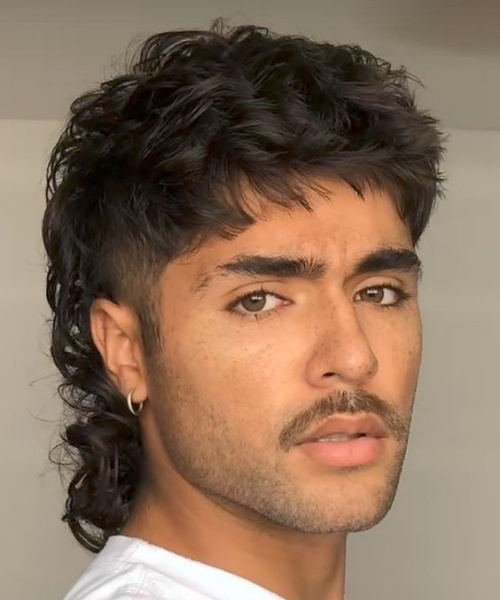
The mullet is a hairstyle that never really left — it just evolved. Born in the 1980s and popularized by rock stars, athletes, and rebels, it stood for carefree attitude and individuality. Fast forward to today, and it’s back with a sleeker, more wearable twist.
Here’s what defines a classic mullet:
- Length: The front and top are kept short to medium, often styled with volume or texture.
- The Disconnect: The back is noticeably longer — sometimes shoulder-length — and doesn’t blend into the sides. This sharp contrast is what gives the mullet its unmistakable silhouette.
- The Motto: Business in the front, party in the back. It’s structured yet wild, balanced yet bold.
Modern mullets might feature subtle fades or texture, but that defining length at the back remains its signature move — the element that sets it apart from every other cut.
Defining the Burst Fade (A Haircut of Technique)
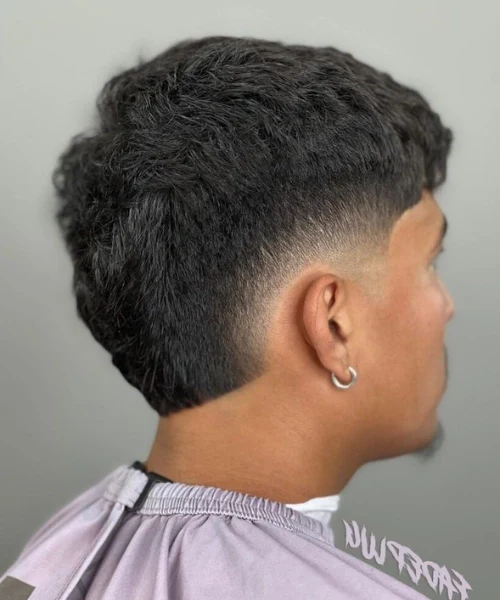
While the mullet is all about shape and attitude, the burst fade is purely about technique — it’s a precise method of blending hair that creates a smooth, curved transition around the ears. Unlike the straight fades that taper evenly from the sides down, the burst fade “bursts” outward in a circular pattern, almost like a sunbeam.
So what exactly makes it special?
- The Burst Shape: The fade starts from a single point — usually behind the ear — and fans out in a half-moon curve. This creates a clean, rounded fade that hugs the natural head shape.
- The Sides: Hair near the temple and behind the ear is cut short (often down to the skin), while the top and back stay longer.
- The Finish: It’s sharp, clean, and highly customizable. You can pair it with mohawks, faux hawks, or even mullets for an edgier vibe.
Think of the burst fade as the “framework” that gives structure to modern styles. It’s not a hairstyle by itself but a finishing technique that defines how neat or dramatic a cut looks. You can also explore the burst taper fade haircut for a softer variation that blends seamlessly while keeping a modern edge.
The Core Distinction: Technique vs. Shape
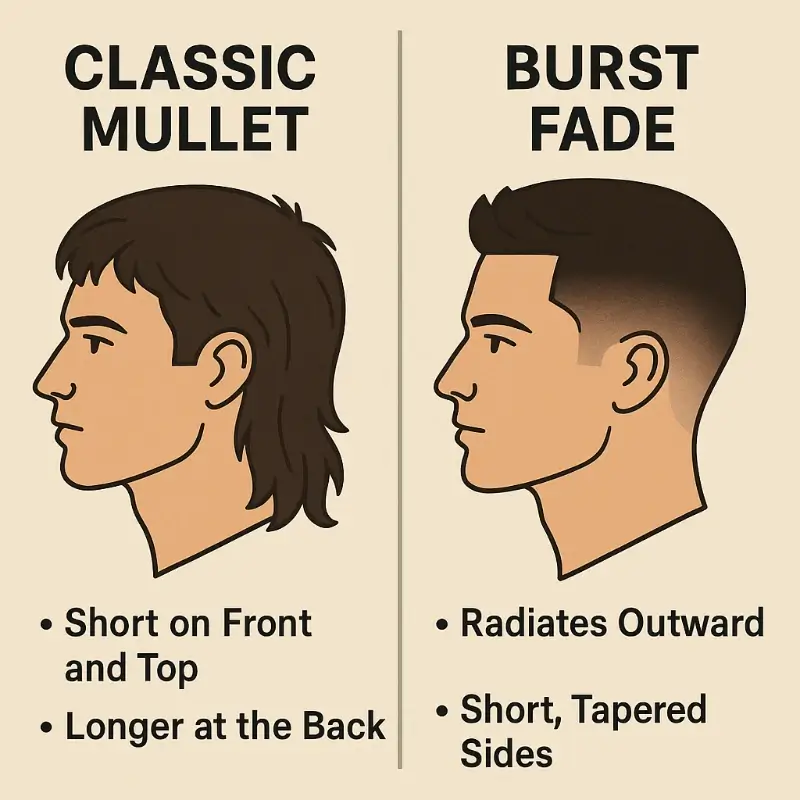
Here’s where most people get mixed up — the mullet and the burst fade aren’t rivals; they belong to different haircut categories altogether.
A mullet defines the shape of your hairstyle. It decides where the hair is short, long, or disconnected. It’s instantly recognizable because of that dramatic length at the back.
A burst fade, on the other hand, is all about technique. It controls how the short hair transitions into longer sections. It’s a skill-based detail, not a full hairstyle.
Let’s break it down even simpler:
- Mullet = silhouette (overall outline of the haircut).
- Burst Fade = blending method (how smoothly the sides transition).
Sides and Back Comparison:
- Mullet: The sides are often left longer or sharply disconnected from the top — there’s little to no blending.
- Burst Fade: The sides are cleanly tapered and curved around the ears, blending flawlessly into the longer sections.
In short, one gives personality, the other gives polish. Together, they can create a balanced, modern look — but on their own, they serve completely different purposes.
Addressing the “Burst Fade Mullet” Hybrid
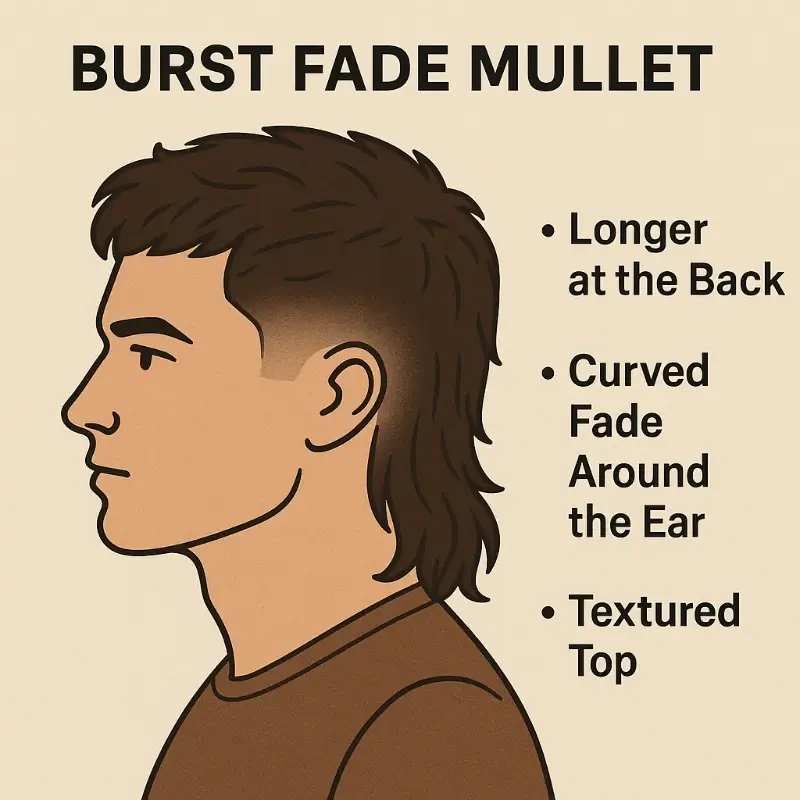
Now that the difference is clear, let’s talk about the style that blurs the lines — the burst fade mullet. It’s the reason so many people ask if a burst fade is just a new-age mullet.
This hybrid combines the mullet’s iconic shape with the burst fade’s modern technique. The result? A haircut that looks edgy, clean, and surprisingly wearable.
This mix of structure and precision makes the burst fade mullet one of the most requested men’s hairstyles in recent years. Barbers love it because it’s versatile — it suits straight, wavy, and curly hair alike. If you prefer a cleaner, more balanced version, check out the taper fade mullet — it offers the same edge but with a softer, more gradual transition.
Here’s how it works:
- It keeps the mullet’s length at the back, maintaining that signature “party in the back” energy.
- Around the ears, it adds a curved fade, giving the sides a neat, sculpted appearance.
- On top, the hair can be styled with texture, curls, or volume — depending on how bold you want to go.
This mix of structure and precision makes the burst fade mullet one of the most requested men’s hairstyles in recent years. Barbers love it because it’s versatile — it suits straight, wavy, and curly hair alike.
So, while a burst fade isn’t a mullet, the hybrid shows how perfectly these two can work together when done right.
Conclusion
So, is the burst fade a mullet? Not quite. The burst fade is a cutting technique, while the mullet is a style and shape. One blends; the other defines. When combined, they form the trendy burst fade mullet — a modern mashup that gives you the best of both worlds: structure with a clean edge.
If you want a subtle, polished taper that still keeps length at the back, ask your barber for a burst fade mullet. But if you’re chasing that bold, throwback energy, stick with a classic mullet — it’s timeless for a reason.
Either way, both styles prove one thing: great hair never really goes out of style — it just finds new ways to make a comeback.
FAQ
1. Is a burst fade the same as a mullet?
No. A burst fade is a blending technique, while a mullet is a hairstyle shape. The fade controls how short hair transitions around the ears, and the mullet defines where the hair is long or short — usually longer at the back.
2. What is a burst fade mullet?
A burst fade mullet is a hybrid hairstyle that combines the clean, rounded fade around the ears with the classic mullet’s longer back. It’s a modern twist that’s become hugely popular among men who want something stylish but still low-maintenance.
3. Can you have a burst fade without a mullet?
Absolutely. The burst fade works with many styles — mohawks, faux hawks, crop cuts, and more. It’s a flexible technique that can elevate almost any haircut.
4. What type of hair works best for a burst fade mullet?
This look suits most hair types, including straight, wavy, and curly. The key is having enough length on top and back to shape the mullet while keeping the sides short enough to show off the fade.
5. How do I ask my barber for a burst fade mullet?
Tell your barber you want a mullet shape with a burst fade around the ears. Bring a reference photo if possible — it helps them match the fade curve and the back length exactly how you want it.
